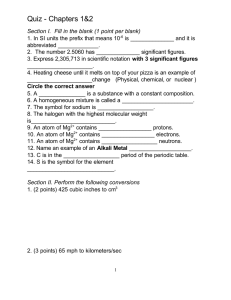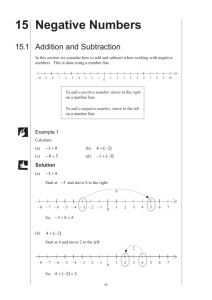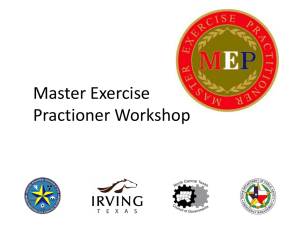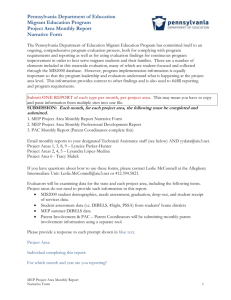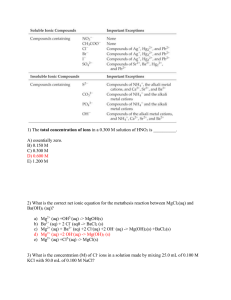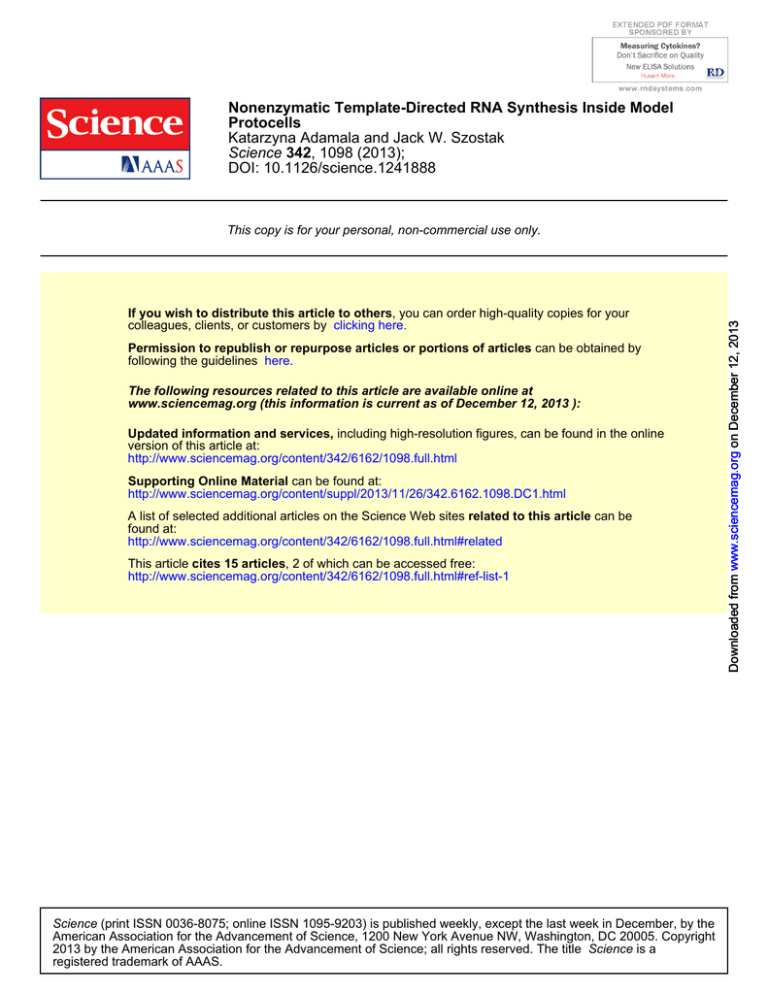
Nonenzymatic Template-Directed RNA Synthesis Inside Model
Protocells
Katarzyna Adamala and Jack W. Szostak
Science 342, 1098 (2013);
DOI: 10.1126/science.1241888
If you wish to distribute this article to others, you can order high-quality copies for your
colleagues, clients, or customers by clicking here.
Permission to republish or repurpose articles or portions of articles can be obtained by
following the guidelines here.
The following resources related to this article are available online at
www.sciencemag.org (this information is current as of December 12, 2013 ):
Updated information and services, including high-resolution figures, can be found in the online
version of this article at:
http://www.sciencemag.org/content/342/6162/1098.full.html
Supporting Online Material can be found at:
http://www.sciencemag.org/content/suppl/2013/11/26/342.6162.1098.DC1.html
A list of selected additional articles on the Science Web sites related to this article can be
found at:
http://www.sciencemag.org/content/342/6162/1098.full.html#related
This article cites 15 articles, 2 of which can be accessed free:
http://www.sciencemag.org/content/342/6162/1098.full.html#ref-list-1
Science (print ISSN 0036-8075; online ISSN 1095-9203) is published weekly, except the last week in December, by the
American Association for the Advancement of Science, 1200 New York Avenue NW, Washington, DC 20005. Copyright
2013 by the American Association for the Advancement of Science; all rights reserved. The title Science is a
registered trademark of AAAS.
Downloaded from www.sciencemag.org on December 12, 2013
This copy is for your personal, non-commercial use only.
REPORTS
16. M. Umetani et al., Nat. Med. 13, 1185–1192 (2007).
17. Materials and methods are available as supplementary
materials on Science Online.
18. C. E. Connor et al., Cancer Res. 61, 2917–2922
(2001).
19. C. T. Guy, R. D. Cardiff, W. J. Muller, Mol. Cell. Biol. 12,
954–961 (1992).
20. E. Y. Lin et al., Am. J. Pathol. 163, 2113–2126
(2003).
21. M. Hansson, E. Ellis, M. C. Hunt, G. Schmitz, A. Babiker,
Biochim. Biophys. Acta 1593, 283–289 (2003).
22. A. Sica et al., Semin. Cancer Biol. 18, 349–355 (2008).
23. M. A. Lyons, A. J. Brown, Lipids 36, 701–711
(2001).
24. G. Llaverias et al., Am. J. Pathol. 178, 402–412
(2011).
25. N. Alikhani et al., Oncogene 32, 961–967 (2013).
26. R. Karuna et al., Atherosclerosis 214, 448–455
(2011).
27. P. M. Sullivan et al., J. Biol. Chem. 272, 17972–17980
(1997).
Expression profiling data on 27HC in MCF7 cells were
uploaded to Gene Expression Omnibus (GEO) (accession no.
GSE46924) and were part of a larger study (GEO accession no.
GSE35428).
Supplementary Materials
www.sciencemag.org/content/342/6162/1094/suppl/DC1
Materials and Methods
Supplementary Text
Figs. S1 to S14
References (28–33)
Acknowledgments: This work was funded by the NIH [grants
K99CA172357 (E.R.N.) and R37DK048807 (D.P.M.)] and
the U.S. Department of Defense (DOD) [grants BC085585
(E.R.N.) and DOD BC094960 (D.P.M.)]. The content of this
paper is solely the responsibility of the authors and does not
necessarily represent the official views of the NIH or DOD.
13 June 2013; accepted 25 October 2013
10.1126/science.1241908
Nonenzymatic Template-Directed RNA
Synthesis Inside Model Protocells
We then asked whether these chelators were
compatible with the Mg2+ catalysis of nonenzymatic template-directed RNA primer extension.
We measured the rate at which an RNA primer
was elongated when annealed to an oligonucleotide with a templating region of C nucleotides, in
the presence of an excess of the activated G monomer guanosine 5′-phosphor(2-methyl)imidazolide
(2MeImpG) (Fig. 2). We examined citric acid,
EDTA, NTA, and a weakly stabilizing chelator
(isocitric acid). In the presence of 50 mM unchelated Mg2+, the primer-extension reaction
proceeded at a rate of 1.4 hour−1, compared to
0.03 hour−1 in the absence of Mg2+ ions. The
addition of four equivalents of EDTA or NTA
resulted in complete abolition of Mg2+ catalysis
(Fig. 2 and figs. S14 and S15), indicating that
the Mg2+ in these samples is chelated in a fashion
incompatible with promoting primer extension.
In contrast, four equivalents of citrate only decreased
the rate of primer extension to 0.67 hour−1. For
comparison, isocitric acid does not fully protect
vesicles (figs. S16 and S17) but also does not
affect the primer extension reaction.
To see whether citrate would allow nonenzymatic RNA copying to proceed within fatty
acid vesicles, we encapsulated an RNA primertemplate complex inside oleate vesicles, added
Mg2+ and citrate, and removed unencapsulated
RNA by size exclusion chromatography. We then
added the activated G monomer 2MeImpG, heated
the sample briefly to allow for rapid monomer
permeation (7), and then incubated it at room
temperature for times up to 24 hours to allow
Katarzyna Adamala1,2 and Jack W. Szostak1*
Efforts to recreate a prebiotically plausible protocell, in which RNA replication occurs within a
fatty acid vesicle, have been stalled by the destabilizing effect of Mg2+ on fatty acid membranes.
Here we report that the presence of citrate protects fatty acid membranes from the disruptive
effects of high Mg2+ ion concentrations while allowing RNA copying to proceed, while also
protecting single-stranded RNA from Mg2+-catalyzed degradation. This combination of properties
has allowed us to demonstrate the chemical copying of RNA templates inside fatty acid vesicles,
which in turn allows for an increase in copying efficiency by bathing the vesicles in a continuously
refreshed solution of activated nucleotides.
T
1
Howard Hughes Medical Institute, Department of Molecular
Biology, and Center for Computational and Integrative Biology, Massachusetts General Hospital, Boston, MA 02114, USA.
2
Dipartimento di Biologia, Università degli Studi di Roma Tre,
Rome, Italy.
*Corresponding author at Howard Hughes Medical Institute,
Department of Molecular Biology, and Center for Computational
and Integrative Biology, 7215 Simches Research Center, Massachusetts General Hospital, 185 Cambridge Street, Boston, MA
02114, USA. E-mail: szostak@molbio.mgh.harvard.edu
1098
and EDTA, that protect oleate vesicles in the presence of at least 10 mM Mg2+ (figs. S5 and S6). In
the presence of chelated Mg2+, oleate vesicles
remained intact but exhibited a modest increase
in the permeability of a small polar molecule
(Fig. 1 and fig. S7) and an even smaller increase
in the leakage of an oligonucleotide. In terms of
vesicle stabilization, citrate was one of the most
effective chelators of Mg2+.
We also examined the stability of model protocell membranes made of myristoleic acid:glycerol
monomyristoleate (2:1) and from the more prebiotically reasonable decanoic acid:decanol:glycerol
monodecanoate (4:1:1). Citrate-chelated Mg2+
caused only a small amount of leakage from these
vesicles, and the stabilizing effect of citrate was seen
for both calcein and oligonucleotides (Fig. 1 and
figs. S8 to S13).
In(% inside vesicles)
he RNA world hypothesis suggests that
the primordial catalysts were ribozymes
(1, 2), whereas biophysical considerations
suggest that the primordial replicating compartments were membranous vesicles composed of
fatty acids and related amphiphiles (3, 4). However, the conditions required for RNA replication chemistry and fatty acid vesicle integrity have
appeared to be fundamentally incompatible (5)
(fig. S1). Both ribozyme-catalyzed and nonenzymatic RNA copying reactions require high (50
to 200 mM) concentrations of Mg2+ (or other divalent) ions (6), but Mg2+ at such concentrations
destroys vesicles by causing fatty acid precipitation.
We developed a screen for small molecules that
protect oleate fatty acid vesicles from disruption by
Mg2+. We used two assays to monitor the leakage
of either a small charged molecule (calcein) or a
larger oligonucleotide, allowing us to distinguish
between increased membrane permeability (faster
calcein release with oligonucleotide retention) and
generalized membrane disruption (rapid release
of both calcein and the oligonucleotide) (figs. S2
to S4). We identified several chelators, including
citrate, isocitrate, oxalate, nitrilotriacetic acid (NTA),
A
B
C
4.6
4.6
4.6
3.8
3.8
3.8
3.0
3.0
3.0
4.6
4.6
4.6
3.8
3.8
3.8
3.0
3.0
0
10
20
time [h]
0
10
20
time [h]
3.0
0
10
20
time [h]
Fig. 1. Citrate stabilizes fatty acid vesicles in the presence of Mg2+ ions. Leakage of a small charged
molecule (calcein, open symbols) and a larger nine-oligomer oligodeoxynucleotide (solid symbols) from fatty
acid vesicles is shown. (A) Oleate vesicles; (B) myristoleate:glycerol monomyristoleate 2:1 vesicles; (C)
decanoate:decanol:glycerol monodecanoate 4:1:1 vesicles. Circles, no MgCl2, no citrate; triangles, 50 mM
MgCl2, 200 mM Na+-citrate. The assay used to obtain these data is described in fig. S3. Lines are linear fits,
coefficient of determination (R2) ≥ 0.97. All experiments were repeated twice; error bars are mean T2 SE.
29 NOVEMBER 2013
VOL 342
SCIENCE
www.sciencemag.org
REPORTS
0
A
a seventh G residue (Fig. 3). In parallel experiments with vesicles composed of mixtures of
shorter-chain lipids, the brief heating step was not
incubation, most of the primer had been extended
by the addition of six G residues, with a smaller
fraction extended to full length by the addition of
the monomer to take part in template-copying
chemistry inside the vesicles. Analysis of the reaction products showed that after 24 hours of
B
C
time [min]
-1
(h )
K
obs
ln[P/P0]
1.4
-0.6
-1.2
10 20 30 40 50
0.7
0.0
0
2
citrate,
vesicles
4
time [h]
Fig. 2. The rate of RNA template-directed primer extension in the presence or absence of Mg2+ chelators and fatty acid vesicles. (A) Time courses
of primer extension on a templating region of four C residues, expressed
as a fraction of unextended primer remaining versus time. Squares, no
chelators; triangles, 200 mM Na+-citrate; circles, 200 mM Na+-citrate and
100 mM oleate vesicles; diamonds, 200 mM EDTA. Lines are linear fits, R2 ≥
0.97; the slope is kobs (hour−1). (B) Rates of primer extension under the
A
time [h]
B
0 6 12 24 48 72
EDTA
no
chelator
indicated conditions; each kinetic experiment was performed in duplicate,
and rates are determined as an average of the three separate runs. Error
bars indicate SEM, n = 3 independent repetitions. (C) Typical polyacrylamide
gel electrophoresis (PAGE) analysis of a template-directed primer extension experiment. Primer extension was carried out in the presence of 200 mM
Na+-citrate. For the gel analysis of the reactions used to obtain this data,
see fig. S15.
C
0 6 12 24 48 72
citrate
D
0 6 12 24 48 72
E
1 2
sample
0 6 12 24 48 72
3
4
fully
extended
primer
fully
extended
primer
primer
primer
Fig. 3. RNA template copying inside model protocell vesicles. (A to D)
Primer extension on a templating region of seven C residues. (A) Control reaction in solution; (B) inside oleate vesicles; (C) inside myristoleate:glycerol
monomyristoleate 2:1 vesicles; (D) inside decanoate:decanol:glycerol
monodecanoate 4:1:1 vesicles. (E) Extension of labeled RNA primer annealed to a mixed base template, templating region sequence GCCG. Sample
1, reaction inside myristoleate:glycerol monomyristoleate 2:1 vesicles; sample
A
1
time 0
2 3 4
time 2h
1 2
3 4
time 4h
1 2
3 4
time 8h
1
2 3 4
time 24h
1 2
2, reaction inside decanoate:decanol:glycerol monodecanoate 4:1:1 vesicles.
Both sample 1 and 2 reactions were performed inside a liposome dialyzer (see
the supplementary materials for the description of the liposome dialyzer) with
a total of 13 buffer exchanges. Sample 3, control reaction in solution with
daily addition of fresh portion of activated monomers, without removing the
hydrolyzed monomers. Sample 4, control reaction in solution, without the addition of fresh monomer.
B
3 4
0
0
time [h]
10
C
20
kobs(h-1)
ln([S]/[S0])
0.03
-0.6
-1.2
Fig. 4. Citrate protects RNA from Mg2+ -catalyzed degradation. (A)
PAGE analysis of cleavage of a DNA oligonucleotide at the site of a single
internal ribonucleotide, at indicated time points; lane 1, no Mg2+, no
citrate; lane 2, 50 mM Mg2+, no citrate; lane 3, no Mg2+, 200 mM citrate; lane
4, 50 mM Mg2+, 200 mM citrate. (B) Quantitation of strand cleavage, expressed
www.sciencemag.org
SCIENCE
0.00
mM Mg2+
0
50
0
50
mM citrate
0
0
200
200
as a fraction of the intact substrate over total substrate versus time. Diamonds,
no Mg2+, no citrate; triangles, no Mg2+, 200 mM citrate; circles, 50 mM Mg2+,
200 mM citrate; squares, 50 mM Mg2+, no citrate. Lines are linear fits, R2 ≥
0.97. (C) Rates of strand cleavage at the ribo linkage with and without Mg2+ and
citrate. Error bars indicate SEM, n = 3 independent repetitions.
VOL 342
29 NOVEMBER 2013
1099
REPORTS
necessary, because of the higher permeability of
such membranes to nucleotide monomers. It is
noteworthy that RNA primer extension occurred
efficiently inside vesicles made of decanoic acid:
decanol:glycerol monodecanoate (4:1:1) (Fig. 3),
because short-chain saturated amphiphilic compounds are more prebiotically plausible than longerchain unsaturated fatty acids such as oleate or
myristoleate. When we encapsulated the RNA
primer-template complex inside POPC vesicles, no
primer extension was observed, because of the impermeability of phospholipid vesicles to the 2MeImpG
monomer (even with a heat pulse) (fig. S18).
The efficiency of nonenzymatic RNA replication can be greatly enhanced by the periodic
addition of fresh portions of activated monomer
to a primer-extension reaction occurring on templates immobilized by covalent linkage to beads
(8). We sought to reproduce this effect by mimicking the flow of an external solution of fresh monomers over vesicles, by periodic dialysis of model
protocells against a solution of fresh activated
monomers (see the supplementary materials for
a description of the liposome reactor dialyzer).
The control primer-extension reaction in solution
shows that the yield of full-length primer-extension
product from copying a GCCG template is very
low, even if fresh monomers are added to the
reaction periodically (Fig. 3E). In contrast, after
repeated exchanges of external solution by dialysis, the proportion of full-length product was
much greater (Fig. 3E).
The high thermal stability of the RNA duplex is a major problem for prebiotic RNA replication (5). Because Mg2+ greatly increases the
melting temperature (Tm) of RNA duplexes, we
asked whether the chelating properties of citrate
would prevent the increase in the Tm of RNA
duplexes caused by the presence of free Mg2+ ions.
We observed a small but reproducible decrease
in Tm in the presence of citrate when compared
to samples containing unchelated Mg2+ (table
S1 and figs. S19 and S20). For example, in the
presence of 50 mM Mg2+ with four equivalents
of citrate, the Tm of the RNA duplex was 71°C,
whereas in the control sample without citrate
the Tm was 75°C.
Citrate also stabilizes RNA by preventing the
Mg2+ catalysis of RNA degradation. Incubating a
13-oligomer oligodeoxynucleotide with one ribo
linkage at 75°C, with and without Mg2+ and citrate,
results in significant strand cleavage at the site of
the single ribo linkage. Four equivalents of citrate,
relative to Mg2+, abolished the Mg2+-catalyzed
degradation (Fig. 4). The observed rate constant (kobs) for cleavage at the ribo linkage, at
75°C in the presence of 50 mM Mg2+ was 0.03
hour−1, whereas in the presence of a fourfold excess of citrate, the rate decreased to 0.004 hour−1.
The chelation of Mg2+ by citrate exhibits two
protective effects in the context of model protocells: Protocell membranes based on fatty acids
are protected from the disruption caused by the
precipitation of fatty acids as Mg2+ salts, and
single-stranded RNA oligonucleotides are pro-
1100
tected from Mg2+-catalyzed degradation. Based
on the known affinity of citrate for Mg2+ (9, 10),
it is clear that the RNA synthesis observed in
the presence of Mg2+ and citrate cannot be due
to residual free Mg2+ (less than 1 mM) and must
be due to catalysis by the Mg2+-citrate complex.
The crystal structure of Mg2+-citrate (11) shows
that the Mg2+ ion is coordinated by the hydroxyl
and two carboxylates of citrate, so that three of
the six coordination sites of octahedral Mg2+ are
occupied by citrate, while the remaining three are
free to coordinate with water or other ligands. The
clear implication is that coordination of Mg2+ by
at most three sites is sufficient for catalysis of
template-directed RNA synthesis, but not for catalysis of RNA degradation or for the precipitation of fatty acids. In the absence of a prebiotic
citrate synthesis pathway [but see (12) for a recent advance], it is of interest to consider prebiotically plausible alternatives to citrate that could
potentially confer similar effects, such as short
acidic peptides. Just such a peptide constitutes the
heart of cellular RNA polymerases, where it binds
and presents the catalytic Mg2+ ion in the active
site of the enzyme.
References and Notes
1. W. Gilbert, Nature 319, 618 (1986).
2. G. F. Joyce, Nature 338, 217–224 (1989).
3. J. M. Gebicki, M. Hicks, Nature 243, 232–234
(1973).
4. D. W. Deamer, J. P. Dworkin, Top. Curr. Chem. 259, 1–27
(2005).
5. J. W. Szostak, The eightfold path to non-enzymatic RNA
replication. J. Sys. Chem. 3:2 (2012).
6. J. C. Bowman, T. K. Lenz, N. V. Hud, L. D. Williams, Curr.
Opin. Struct. Biol. 22, 262–272 (2012).
7. S. S. Mansy, J. W. Szostak, Proc. Natl. Acad. Sci. U.S.A.
105, 13351–13355 (2008).
8. C. Deck, M. Jauker, C. Richert, Nat. Chem. 3, 603–608
(2011).
9. A. K. Covington, E. Y. Danish, J. Solution Chem. 38,
1449–1462 (2009).
10. M. Walser, J. Phys. Chem. 65, 159–161 (1961).
11. C. K. Johnson, Acta Crystallogr. 18, 1004–1018 (1965).
12. C. Butch et al., J. Am. Chem. Soc. 135, 13440–13445
(2013).
Acknowledgments: We thank A. Engelhart, C. Hentrich,
A. Larsen, N. Kamat, and A. Björkbom for discussions and help
with manuscript preparation and A. Gifford for help
with vesicle leakage experiments. This work was supported in
part by NASA Exobiology grant NNX07AJ09G. J.W.S. is an
investigator of the Howard Hughes Medical Institute. Raw
data are presented in the supplementary materials. The
instructions for assembling the Liposome Dialyzer are available
at http://molbio.mgh.harvard.edu/szostakweb/.
Supplementary Materials
www.sciencemag.org/content/342/6162/1098/suppl/DC1
Materials and Methods
Supplementary Text
Figs. S1 to S21
Tables S1 to S3
Liposome Dialyzer Instructions
References (13–15)
13 June 2013; accepted 25 September 2013
10.1126/science.1241888
Primate Transcript and Protein
Expression Levels Evolve Under
Compensatory Selection Pressures
Zia Khan,1* Michael J. Ford,2 Darren A. Cusanovich,1 Amy Mitrano,1
Jonathan K. Pritchard,1,3*† Yoav Gilad1*
Changes in gene regulation have likely played an important role in the evolution of primates.
Differences in messenger RNA (mRNA) expression levels across primates have often been
documented; however, it is not yet known to what extent measurements of divergence in mRNA
levels reflect divergence in protein expression levels, which are probably more important in
determining phenotypic differences. We used high-resolution, quantitative mass spectrometry to
collect protein expression measurements from human, chimpanzee, and rhesus macaque
lymphoblastoid cell lines and compared them to transcript expression data from the same samples.
We found dozens of genes with significant expression differences between species at the mRNA
level yet little or no difference in protein expression. Overall, our data suggest that protein
expression levels evolve under stronger evolutionary constraint than mRNA levels.
M
easurements of mRNA levels have revealed substantial differences across
primate transcriptomes (1–3) and have
1
Department of Human Genetics, University of Chicago, Chicago, IL 60637, USA. 2MS Bioworks, LLC, 3950 Varsity Drive,
Ann Arbor, MI 48108, USA. 3Howard Hughes Medical Institute,
University of Chicago, Chicago, IL 60637, USA.
*Corresponding author. E-mail: zia@uchicago.edu (Z.K.);
pritch@stanford.edu ( J.K.P); gilad@uchicago.edu (Y.G.)
†Present address: Departments of Genetics and Biology,
Stanford University, Stanford, CA 94305, USA.
29 NOVEMBER 2013
VOL 342
SCIENCE
led to the identification of putatively adaptive
changes in transcript expression (4). Traditionally, measurements of divergence in mRNA levels
are assumed to be good proxies for divergence
in protein levels. However, there are numerous
mechanisms by which protein expression may be
regulated independently of mRNA levels (5, 6).
If transcript and protein expression levels are often uncoupled, mRNA levels may evolve under
reduced constraint as changes at the transcript
level could be buffered or compensated for at the
www.sciencemag.org

